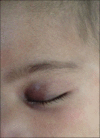Ophthalmic Artery Chemosurgery: A Nursing Perspective
- PMID: 28695166
- PMCID: PMC5473091
- DOI: 10.4103/2347-5625.207737
Ophthalmic Artery Chemosurgery: A Nursing Perspective
Abstract
Retinoblastoma (RB) is the most common primary cancer to affect the eyes in children with approximately 350 cases/year in the United States and 8000 worldwide. Today, sadly, 50% of children with RB worldwide die from their disease. In our experience, utilization of ophthalmic artery chemosurgery (OAC) has transformed the treatment plan for patients; with over 1500 procedures performed, our survival rate exceeds 98%. It is now our standard first-line therapy for RB. OAC is a surgical outpatient procedure which delivers concentrated doses of chemotherapy directly to the tumor without the toxicities of systemic chemotherapy. Our team approach and nursing management of these patients are the focus of this article. Nursing navigation and collaboration after OAC is vital and requires a combined effort by the nurses along with physicians, interventional radiologists, and the patient's families to ensure appropriate follow-up is established. Proper patient education throughout the process is crucial as is open and available communication for parents of patients with the nursing staff. The success in our treatment of this disease can be much accredited to the multidisciplinary team approach, with nursing playing an integral part in the support and management of these patients.
Keywords: Coordination; nursing navigation; ophthalmic artery chemosurgery; retinoblastoma.
Conflict of interest statement
There are no conflicts of interest.
Figures
References
-
- Abramson DH. Retinoblastoma: Saving life with vision. Annu Rev Med. 2014;65:171–84. - PubMed
-
- Chévez-Barrios P, Eagle RC, Marback EF. In: Histopathologic features and prognostic factors. Clinical Ophthalmic Oncology. Singh AD, Murphree AL, Damato BE, editors. Heidelberg: Springer Berlin; 2015. pp. 167–83.
-
- Gallie BL, Zhao J, Vandezande K, White A, Chan HS. Global issues and opportunities for optimized retinoblastoma care. Pediatr Blood Cancer. 2007;49(7 Suppl):1083–90. - PubMed
-
- Youseff YA, Soliman SE, Astudillo PP, Durairaj P, Dimaras H, Chan HS, et al. Intra-arterial chemotherapy for retinoblastoma a systematic review. JAMA Ophthalmol. 2016;134:584–91. - PubMed
Publication types
LinkOut - more resources
Full Text Sources
Other Literature Sources




